overheating TOYOTA GR86 2022 Owners Manual (in English)
[x] Cancel search | Manufacturer: TOYOTA, Model Year: 2022, Model line: GR86, Model: TOYOTA GR86 2022Pages: 582, PDF Size: 86.38 MB
Page 14 of 582
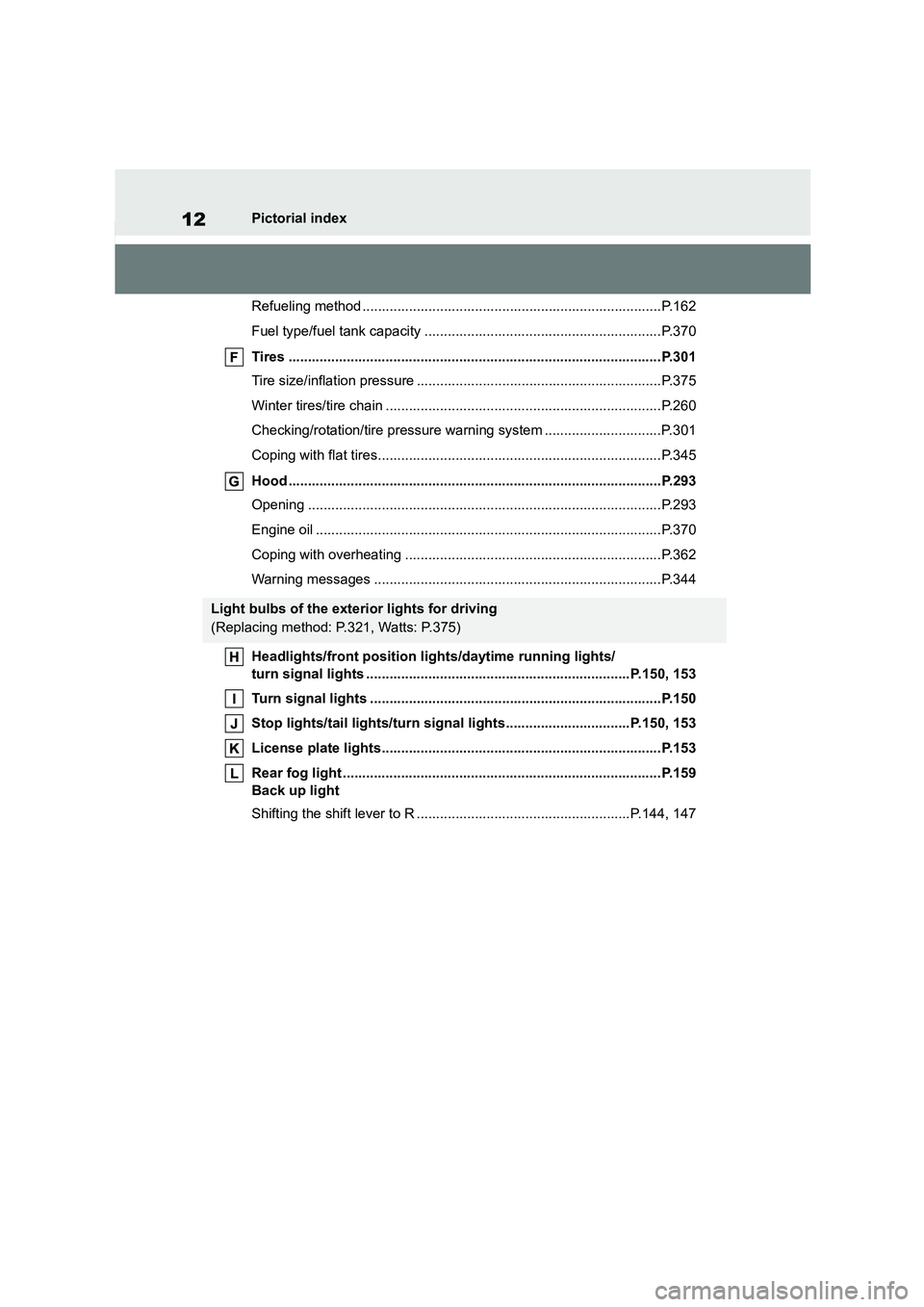
12Pictorial index
Refueling method .............................................................................P.162
Fuel type/fuel tank capacity .............................................................P.370
Tires ................................................................................................P.301
Tire size/inflation pressure ...............................................................P.375
Winter tires/tire chain .......................................................................P.260
Checking/rotation/tire pressure warn ing system ..............................P.301
Coping with flat tires.........................................................................P.345
Hood ................................................................................................P.293
Opening ...........................................................................................P.293
Engine oil .........................................................................................P.370
Coping with overheating ..................................................................P.362
Warning messages ..........................................................................P.344
Headlights/front position lights/daytime running lights/
turn signal lights ....................................................................P.150, 153
Turn signal lights ...........................................................................P.150
Stop lights/tail lights/turn signal lights................................P.150, 153
License plate lights........................................................................P.153
Rear fog light ..................................................................................P.159
Back up light
Shifting the shift lever to R .......................................................P.144, 147
Light bulbs of the exterior lights for driving
(Replacing method: P.321, Watts: P.375)
Page 92 of 582

902-1. Instrument cluster
tor is disabled. The setting can be ena-
bled/disabled on of the
multi-information display. ( P.377)
The engine speed at which the REV
indicator is displayed can be changed
on of the multi-information display.
( P.377)
■Outside temperature display
●In the following situations, the correct
outside temperature may not be dis- played, or the display may take longer
than normal to change:
• When stopped, or driving at low speeds (less than 20 km/h [12 mph])
• When the outside temperature has
changed suddenly (at the entrance/exit of a garage, tunnel, etc.)
●When “--” is displayed, the system may be malfunctioning.
Take your vehicle to any authorized
Toyota retailer or Toyota authorized repairer, or any reliable repairer.
■Liquid crystal display
P. 9 3
■Customization
The meter display ca n be customized on
the multi-information display. ( P.377)
■Changing the display
Press the display change button
until the desired item is displayed.
WA R N I N G
■The information display at low
temperatures
Allow the interior of the vehicle to warm up before using the liquid crys-
tal information display. At extremely
low temperatures, the information dis- play monitor may respond slowly, and
display changes may be delayed.
For example, there is a lag between
the driver’s shifting and the new gear number appearing on the display.
This lag could cause the driver to
downshift again, causing rapid and excessive engine braking and possi-
bly an accident resulting in death or
injury.
NOTICE
■To prevent damage to the engine
and its components
●Do not let the indicator needle of
the tachometer enter the red zone,
which indicates the maximum
engine speed.
●Pay extra attention to the engine
speed when the engine is cold, as the red zone will be lower than nor-
mal.
●If the engine coolant temperature
gauge indicator is flashing, the
engine may be overheating. Imme- diately stop the vehicle in a safe
place, and check the engine after it
has cooled completely. ( P.362)
Odometer and trip meter
display
Page 137 of 582

135
4
4-1. Before driving
Driving
WA R N I N G
●Do not leave a door or window
open if the curved glass is coated
with a metallized film such as a sil- ver-colored one. Reflected sunlight
may cause the glass to act as a
lens, causing a fire.
●Always apply the parking brake,
shift the shift lever to P (vehicles
with an automatic transmission), stop the engine and lock the vehi-
cle.
Do not leave the vehicle unat- tended while the engine is running.
If the vehicle is parked with the shift
lever in P but the parking brake is not set, the vehicl e may start to
move, possibly leading to an acci-
dent.
●Do not touch the exhaust pipes
while the engine is running or immediately after turning the engine
off.
Doing so may cause burns.
■When taking a nap in the vehicle
Always turn the engine off. Otherwise, if you accidentally move the shift lever
or depress the accelerator pedal, this
could cause an accident or fire due to engine overheating. Additionally, if the
vehicle is parked in a poorly ventilated
area, exhaust gases may collect and enter the vehicle, leading to death or
a serious health hazard.
■When braking
●When the brakes are wet, drive
more cautiously. Braking distance increases when
the brakes are wet, and this may
cause one side of the vehicle to brake differently than the other
side. Also, the parking brake may
not securely hold the vehicle.
●If the brake booster device does not operate, do not follow other vehi-
cles closely and avoid hills or sharp
turns that require braking. In this case, braking is still possible,
but the brake pedal should be
depressed more firmly than usual. Also, the braking distance will
increase. Have your brakes fixed
immediately.
●Do not pump the brake pedal if the
engine stalls. Each push on the brake pedal uses
up the reserve for the
power-assisted brakes.
●The brake system consists of 2 indi-
vidual hydraulic systems; if one of the systems fails, the other will still
operate. In this case, the brake
pedal should be depressed more firmly than usual and the braking
distance will increase. Have your
brakes fixed immediately.
■If the vehicle becomes stuck
Do not spin the wheels excessively when any of the tires is up in the air,
or the vehicle is stuck in sand, mud,
etc. This may damage the driveline components or propel the vehicle for-
ward or backward, causing an acci-
dent.
NOTICE
■Pre-driving check
Trapping small animals in the cooling
fan and belts of the engine may result
in a malfunction. Check that no small animal enters the engine compart-
ment and under the vehicle before
starting the engine.
Page 142 of 582
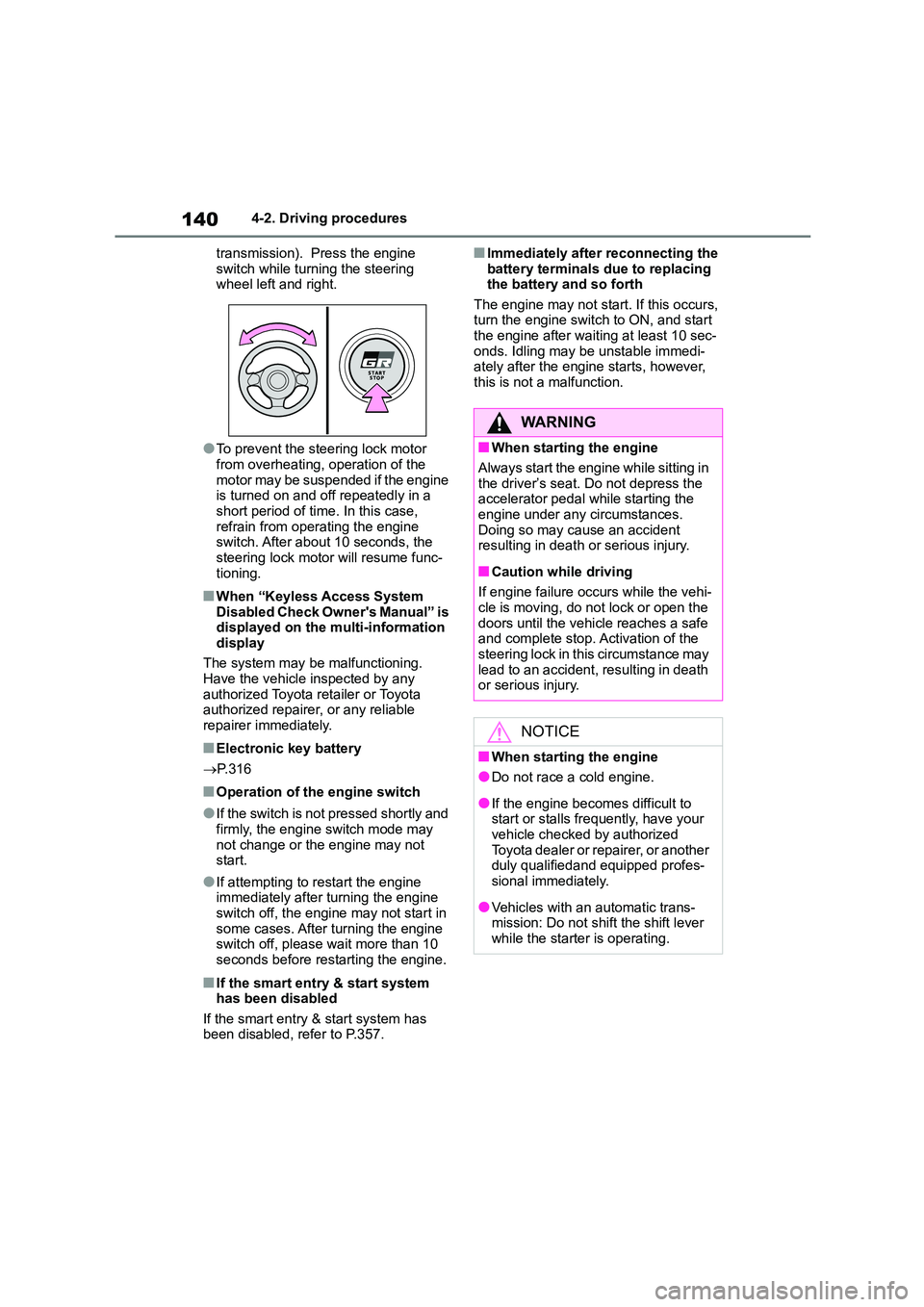
1404-2. Driving procedures
transmission). Press the engine
switch while turning the steering wheel left and right.
●To prevent the steering lock motor from overheating, operation of the
motor may be suspended if the engine
is turned on and off repeatedly in a short period of time. In this case,
refrain from operating the engine
switch. After about 10 seconds, the steering lock motor will resume func-
tioning.
■When “Keyless Access System
Disabled Check Owner's Manual” is displayed on the multi-information
display
The system may be malfunctioning. Have the vehicle inspected by any
authorized Toyota retailer or Toyota
authorized repairer, or any reliable repairer immediately.
■Electronic key battery
P.316
■Operation of the engine switch
●If the switch is not pressed shortly and
firmly, the engine switch mode may
not change or the engine may not start.
●If attempting to restart the engine immediately after turning the engine
switch off, the engine may not start in
some cases. After turning the engine switch off, please wait more than 10
seconds before restarting the engine.
■If the smart entry & start system
has been disabled
If the smart entry & start system has been disabled, refer to P.357.
■Immediately after reconnecting the
battery terminals due to replacing the battery and so forth
The engine may not start. If this occurs,
turn the engine switch to ON, and start the engine after waiting at least 10 sec-
onds. Idling may be unstable immedi-
ately after the engine starts, however, this is not a malfunction.
WA R N I N G
■When starting the engine
Always start the engine while sitting in
the driver’s seat. Do not depress the accelerator pedal while starting the
engine under any circumstances.
Doing so may cause an accident resulting in death or serious injury.
■Caution while driving
If engine failure occurs while the vehi-
cle is moving, do not lock or open the
doors until the vehicle reaches a safe and complete stop. Activation of the
steering lock in this circumstance may
lead to an accident, resulting in death or serious injury.
NOTICE
■When starting the engine
●Do not race a cold engine.
●If the engine becomes difficult to
start or stalls frequently, have your vehicle checked by authorized
Toyota dealer or repairer, or another
duly qualifiedand equipped profes- sional immediately.
●Vehicles with an automatic trans-mission: Do not shi ft the shift lever
while the starter is operating.
Page 153 of 582
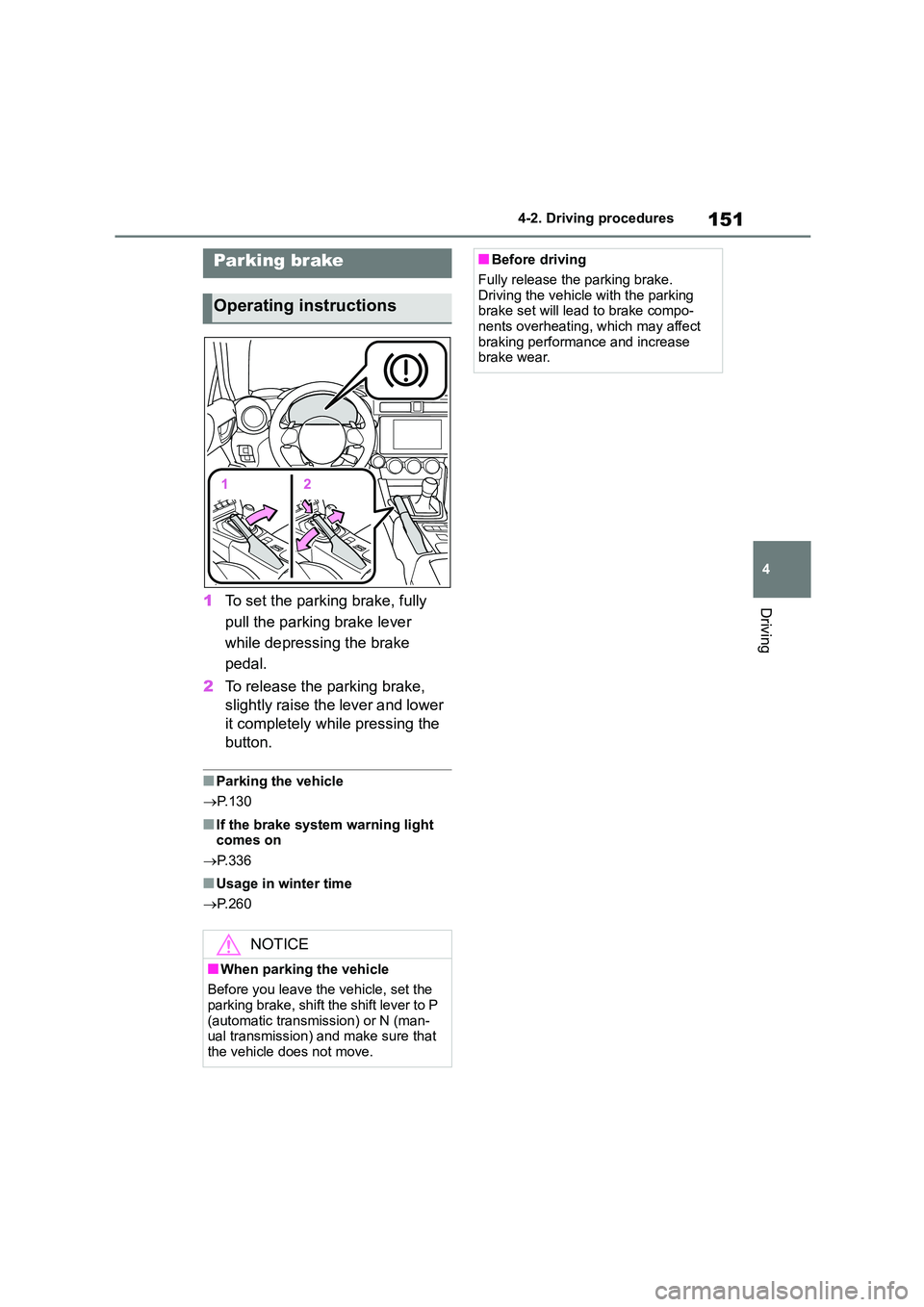
151
4
4-2. Driving procedures
Driving1 To set the parking brake, fully
pull the parking brake lever
while depressing the brake
pedal.
2 To release the parking brake,
slightly raise the lever and lower
it completely while pressing the
button.
■Parking the vehicle
P.130
■If the brake system warning light comes on
P.336
■Usage in winter time
P.260
Parking brake
Operating instructions
NOTICE
■When parking the vehicle
Before you leave the vehicle, set the
parking brake, shift the shift lever to P
(automatic transmission) or N (man- ual transmission) and make sure that
the vehicle does not move.
■Before driving
Fully release the parking brake.
Driving the vehicle with the parking
brake set will lead to brake compo- nents overheating, which may affect
braking performance and increase
brake wear.
Page 260 of 582

2584-6. Using other driving systems
*1: Vehicles with an automatic transmission
*2: Vehicles with a manual transmission
■Sounds and vibrations caused by
the ABS, brake assist, TRC and
VSC systems
●A sound may be heard from the
engine compartment when the brake pedal is depressed repeatedly, when
the engine is started or just after the
vehicle begins to move. This sound does not indicate that a malfunction
has occurred in any of these systems.
●Any of the following conditions may
occur when the above systems are
operating. None of these indicates that a malfunction has occurred.
• Vibrations may be felt through the
vehicle body and steering. • A motor sound may be heard after the
vehicle comes to a stop.
• The brake pedal may pulsate slightly after the ABS is activated.
• The brake pedal may move down
slightly after the ABS is activated.
■EPS operation sound
When the steering wheel is operated, a
motor sound (whirring sound) may be
heard. This does not indicate a malfunc- tion.
■Automatic reactivation of TRC and
VSC systems
After turning the TRC and VSC systems off, the systems will be automatically
reactivated in the following situations:
●When the engine switch is turned off.
●If only the TRC system is turned off, the TRC will turn on when vehicle
speed is more than approximately 50
km/h (31 mph).
If both the TRC and VSC systems are turned off, automatic reactivation will
not occur when vehicle speed
increases.
■Reduced effectiveness of the EPS system
The effectiveness of the EPS system is
reduced to prevent the system from
overheating when there is frequent
steering input over an extended period
of time. The steering wheel may feel heavy as a result. Should this occur,
refrain from excessive steering input or
stop the vehicle and turn the engine off. The EPS system should return to nor-
mal after a little while.
■Automatic deactivation of
“TRACK” mode
When the engine switch is turned off
after driving in “TRACK” mode, the
mode is automatically deactivated.
■Operating conditions of emergency brake signal
When the following three conditions are
met, the emergency brake signal will operate:
●The emergency flashers are off.
●Actual vehicle speed is over 60 km/h
(38 mph).
●The brake pedal is depressed in a
manner that cause the system to judge from the vehicle deceleration
that this is a sudden braking opera-
tion.
■Automatic system cancelation of emergency brake signal
The emergency brake signal will turn off
in any of the following situations:
●The emergency flashers are turned
on.
●The brake pedal is released.
●The system judges from the vehicle
deceleration that is not a sudden brak-
ing operation.
■Customization
Some functions can be customized. ( P.377)
Page 272 of 582

2705-1. Using the air conditioning system
1Rapid heating
2 Normal heating
When not in use, put the switch in the
neutral position. The indicator will turn
off.
■The seat heaters can be used when
The engine switch is in ON.
■When not in use
Turn the seat heater off. The indicator light goes off.
WA R N I N G
■To prevent overheating and
minor burn injuries
Observe the following precautions when using the seat heaters.
●Do not cover the seat with a blanket or cushion when using the seat
heater.
●Do not use seat heater more than
necessary.
Page 364 of 582
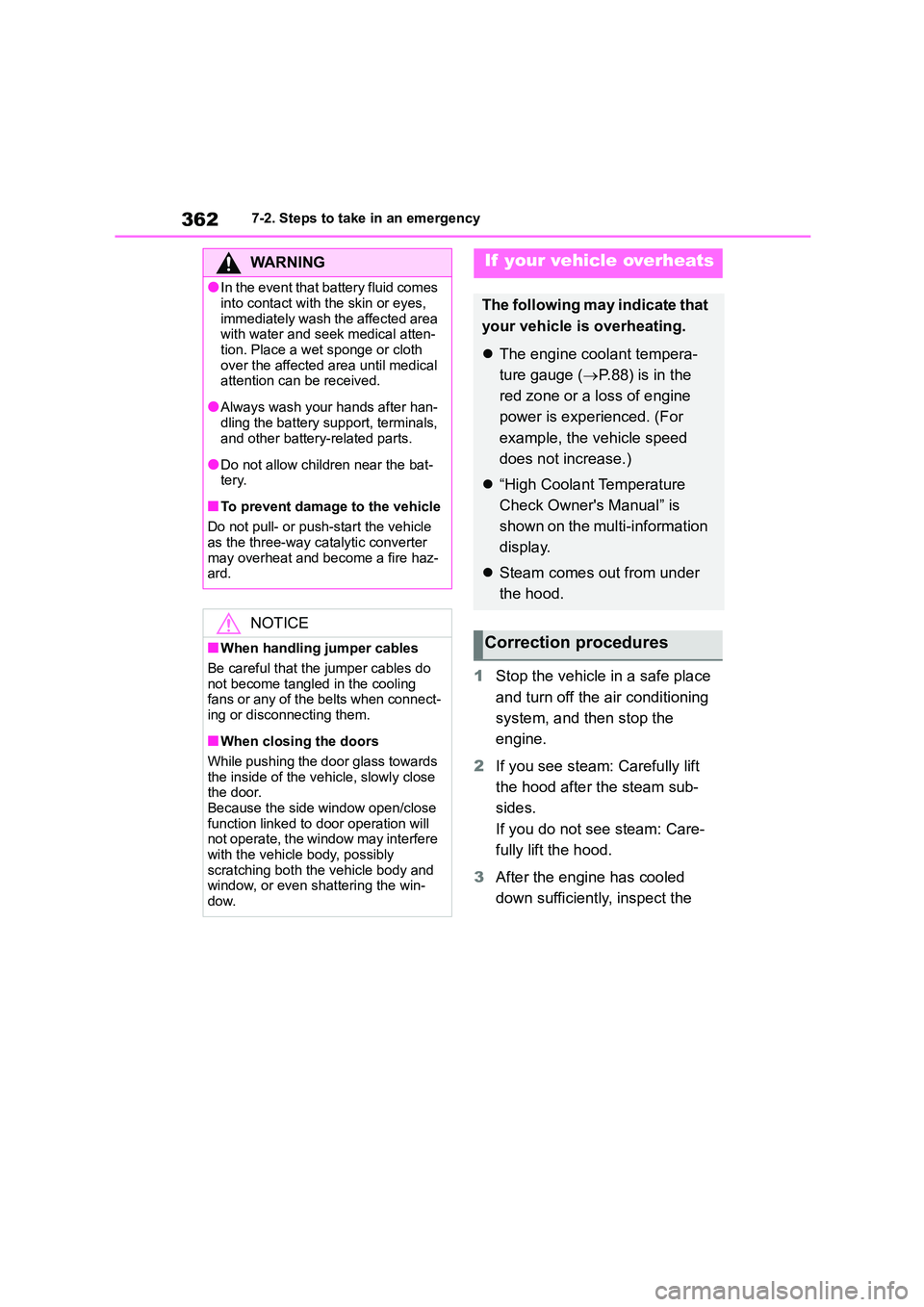
3627-2. Steps to take in an emergency
1Stop the vehicle in a safe place
and turn off the air conditioning
system, and then stop the
engine.
2 If you see steam: Carefully lift
the hood after the steam sub-
sides.
If you do not see steam: Care-
fully lift the hood.
3 After the engine has cooled
down sufficiently, inspect the
WA R N I N G
●In the event that battery fluid comes
into contact with the skin or eyes,
immediately wash the affected area with water and seek medical atten-
tion. Place a wet sponge or cloth
over the affected area until medical attention can be received.
●Always wash your hands after han-
dling the battery support, terminals, and other battery-related parts.
●Do not allow children near the bat-tery.
■To prevent damage to the vehicle
Do not pull- or push-start the vehicle
as the three-way catalytic converter
may overheat and become a fire haz- ard.
NOTICE
■When handling jumper cables
Be careful that the jumper cables do
not become tangled in the cooling fans or any of the belts when connect-
ing or disconnecting them.
■When closing the doors
While pushing the door glass towards
the inside of the vehicle, slowly close the door.
Because the side window open/close
function linked to door operation will not operate, the window may interfere
with the vehicle body, possibly
scratching both the vehicle body and window, or even shattering the win-
dow.
If your vehicle overheats
The following may indicate that
your vehicle is overheating.
The engine coolant tempera-
ture gauge ( P.88) is in the
red zone or a loss of engine
power is experienced. (For
example, the vehicle speed
does not increase.)
“High Coolant Temperature
Check Owner's Manual” is
shown on the multi-information
display.
Steam comes out from under
the hood.
Correction procedures
Page 392 of 582
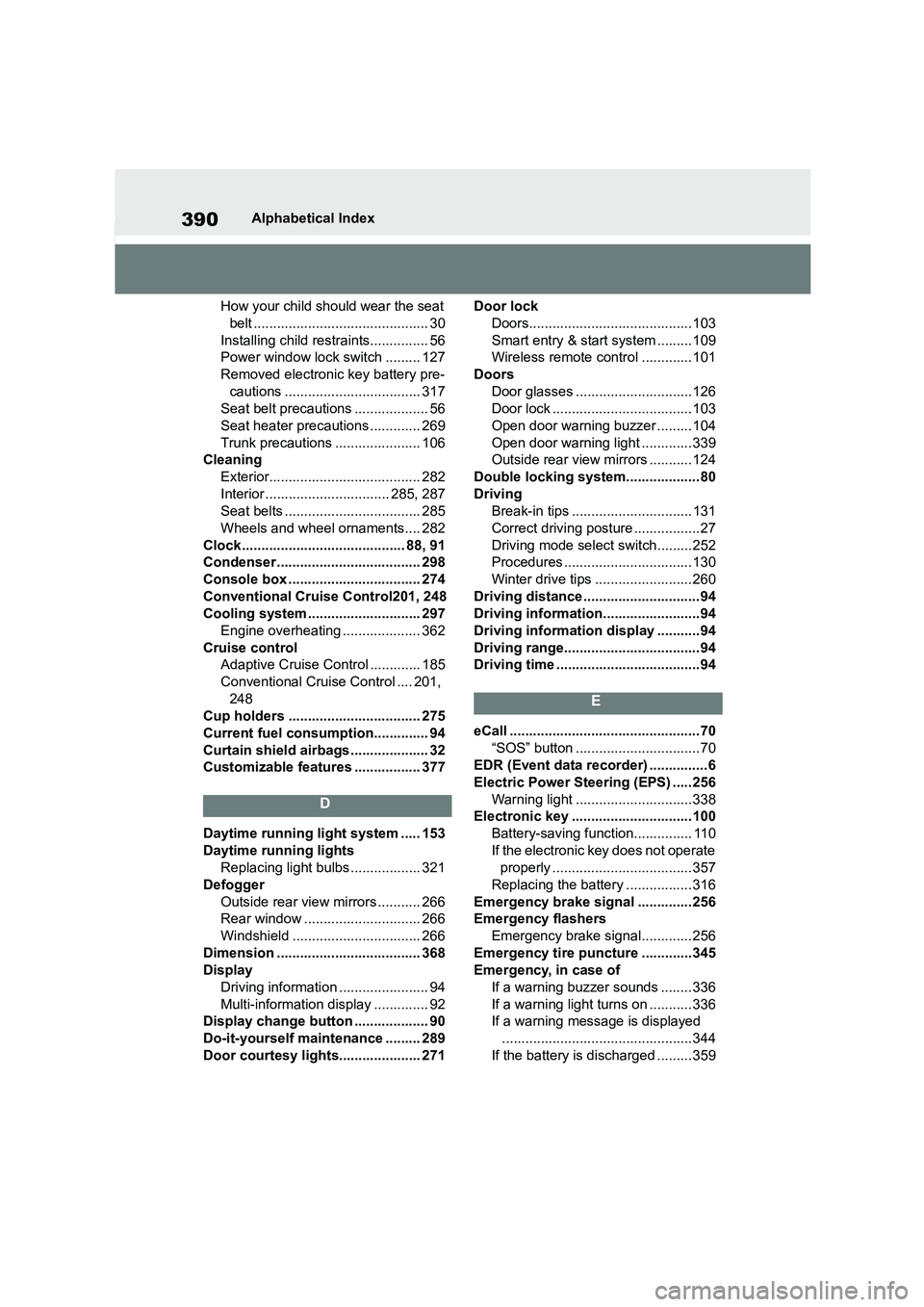
390Alphabetical Index
How your child should wear the seat
belt ............................................. 30
Installing child restraints............... 56
Power window lock switch ......... 127
Removed electronic key battery pre-
cautions ................................... 317
Seat belt precautions ................... 56
Seat heater precautions ............. 269
Trunk precautions ...................... 106
Cleaning
Exterior....................................... 282
Interior ................................ 285, 287
Seat belts ................................... 285
Wheels and wheel ornaments.... 282
Clock.......................................... 88, 91
Condenser..................................... 298
Console box .................................. 274
Conventional Cruise Control201, 248
Cooling system ............................. 297
Engine overheating .................... 362
Cruise control
Adaptive Cruise Control ............. 185
Conventional Cruise Control .... 201,
248
Cup holders .................................. 275
Current fuel consumption.............. 94
Curtain shield airbags .................... 32
Customizable features ................. 377
D
Daytime running light system ..... 153
Daytime running lights
Replacing light bulbs .................. 321
Defogger
Outside rear view mirrors ........... 266
Rear window .............................. 266
Windshield ................................. 266
Dimension ..................................... 368
Display
Driving information ....................... 94
Multi-information display .............. 92
Display change button ................... 90
Do-it-yourself maintenance ......... 289
Door courtesy lights..................... 271
Door lock
Doors.......................................... 103
Smart entry & start system .........109
Wireless remote control .............101
Doors
Door glasses ..............................126
Door lock .................................... 103
Open door warning buzzer ......... 104
Open door warning light ............. 339
Outside rear view mirrors ........... 124
Double locking system................... 80
Driving
Break-in tips ............................... 131
Correct driving posture ................. 27
Driving mode select switch.........252
Procedures ................................. 130
Winter drive tips ......................... 260
Driving distance .............................. 94
Driving information......................... 94
Driving information display ........... 94
Driving range................................... 94
Driving time ..................................... 94
E
eCall ................................................. 70
“SOS” button ................................ 70
EDR (Event data recorder) ............... 6
Electric Power Steer ing (EPS) ..... 256
Warning light ..............................338
Electronic key ............................... 100
Battery-saving function............... 110
If the electronic key does not operate
properly .................................... 357
Replacing the battery ................. 316
Emergency brake signal .............. 256
Emergency flashers
Emergency brake signal............. 256
Emergency tire puncture .............345
Emergency, in case of
If a warning buzzer sounds ........ 336
If a warning light turns on ........... 336
If a warning message is displayed
.................................................344
If the battery is discharged ......... 359
Page 393 of 582

391Alphabetical Index
If the electronic key does not operate properly .................................... 357
If the engine will not start ........... 355
If the fuel filler door cannot be opened..................................... 357
If the vehicle is submerged or water on the road is rising ................. 327
If you have a flat tire................... 345
If you lose your keys .................. 356
If you think something is wrong.. 334
If your vehicle becomes stuck .... 364
If your vehicle has to be stopped in an emergency .......................... 326
If your vehicle needs to be towed
................................................. 329
If your vehicle overheats ............ 362
Engine
ACCESSORY mode .................. 141
Compartment ............................. 295
Engine switch ............................. 139
Fuel pump shut of f system ......... 335
Hood .......................................... 293
How to start the engine .............. 139
Identification number.................. 369
If the engine will not start ........... 355
If your vehicle has to be stopped in
an emergency .......................... 326
Ignition switch (engine switch) ... 139
Overheating ............................... 362
Tachometer .................................. 88
Engine coolant Capacity ..................................... 372
Checking .................................... 297
Preparing and checking before win-ter ............................................ 260
Engine coolant temperature gauge ....................................................... 88
Engine immobilizer system ........... 79
Engine oil Capacity ..................................... 370
Checking .................................... 295
Preparing and checking before win-ter ............................................ 260
Warning light .............................. 337
Engine oil temperature gauge ....... 94 Engine switch................................139
Auto power off function .............. 142
Changing the engine switch modes.................................................141
If your vehicle has to be stopped in
an emergency ..........................326
EPS (Electric Power Steering) ..... 256 Warning light ..............................338
Event data recorder (EDR) ............... 6
Extended headlight lighting system ..................................................... 155
EyeSight ........................................165 Adaptive Cruise Control .............185
Conventional Cruise Control ...... 201
Lane Departure Warning ............214
Lane Sway Warning ................... 216
Lead Vehicle Start Alert .............. 218
Malfunction ................................. 222
Pre-Collision Braking System..... 175
Pre-Collision Throttle Management
.................................................209
Temporary stop ..........................222
F
Flat tire
Tire pressure warning system .... 303
Vehicles without a spare tire ...... 345
Floor mats ....................................... 26
Fluid Automatic transmission .............. 373
Brake .......................................... 374
Manual transmission ..................373
Washer ....................................... 300
Fog lights....................................... 159
Switch.........................................159
Front position lights Wattage ......................................375
Front seats Adjustment ................................. 117
Cleaning .............................285, 287
Correct driving posture ................. 27
Head restraints ...........................120
Seat heaters ............................... 269